tim kiem
Thứ Năm, 29 tháng 9, 2011
Thứ Ba, 27 tháng 9, 2011
Iceland's 'zero-emission' data center
| | By John D. Sutter, CNN September 27, 2011 -- Updated 2237 GMT (0637 HKT) | Filed under: Innovations |

(CNN) -- A cloud-computing company is building what it calls "the world's first zero-emission data center" in Iceland.
The British company Colt says the data center will be powered fully by geothermal and hydroelectric sources of energy, which Iceland has in spades. The blog Earth2Tech, where we spotted this story, says Iceland could become a "magnet" for data centers because of the wide availability of renewable energy sources there.
"Why is a country, which blipped on the global news radar in recent months because of its ash-spewing volcano and hard-hit financial markets, such a hot place to construct data centers that could house thousands of servers and run web services for Internet giants?" asks Katie Fehrenbacher from that GigaOm network blog. "First off: location. Its placement between Europe and the U.S. means that companies in the U.S. can run their Web services for both continents in one location, potentially saving money," says Fehrenbacher.
"Secondly, because of its abundant hydropower and geothermal power, Iceland can offer data center services powered by 100% clean power for the same price or less than Web services powered by fossil fuel-based grids in other locations. Internet companies can use the clean power to market their green services, or take advantage of green subsidies in certain markets."
Bernard Geoghegan, an executive at Colt, says his company chose Iceland because of renewable energy:
"The location of this data center has been strategically placed so that it will be the first in the world to use 100% dual sourced renewable energy sources," he writes in a company blog post.
This development is significant because data centers -- giant warehouses of computers that store information that's on the Internet -- use lots of electricity. In the United States, these info factories account for about 1.5% of all energy use, according to a 2007 report from the U.S. Environmental Protection Agency. Total data center energy use was expected to double by this year.
Worldwide, data center energy use increased 56% from 2005 to 2010, according to a report from Stanford's Jonathan Koomey, which was commissioned by The New York Times. That's less than was expected, but is still significant, the report says.
Colt expects its Iceland data center to be up and running within four months.
Other data centers have claimed to purchase their energy from 100% renewable sources in the past, and there's some debate about what role renewable energy should play in the greening of data centers. More important than purchasing green power is using less of it, writes Ian Bitterlin at the blog Datacenter Dynamics. To this point, the EPA recently created a program to help data centers go green.
The construction of the "zero-emission" data center in Iceland highlights another trend in information processing: Data centers are often located in bizarre places.
When WikiLeaks was all over the news earlier this year, it was revealed that the secrets-leaking website stored at least some of its files in a James-Bond style data center inside a mountain in Sweden.
In the U.S., these data center are often placed near rivers, so they can use the water to cool down the computer servers, or in rural areas, where they don't attract too much attention.
I took a trip to a data center a couple of years ago, and you can check out that story here.
Poll: More than half of teens, young adults harassed online
| | By Doug Gross, CNN September 27, 2011 -- Updated 2142 GMT (0542 HKT) | Filed under: Web |

(CNN) -- More than half of all teens and young adults say they have been bullied or harassed online, according to the results of a new poll on Internet behavior.
In an Associated Press/MTV poll, 56 percent of respondents, who were between 14 and 24 years old, said they had "experienced abuse" through digital media.
That's up from 50 percent in a similar 2009 survey.
Some of the most common forms of harassment include posting something online that's not true, writing things online that are "mean" and sharing texts or other messages that were meant to stay private, according to the results.
And while the ability to stay anonymous online is often cited as a reason why digital bullying can get so bad, survey respondents said that, more often than not, that's not the case.
"Most say the perpetrators of the bad behavior are people they know very well," the survey reads.
One out of three resopndents also said they've taken part in so-called "sexting," which includes sending and receiving nude photos or video or sexually charged text. Seventy-one percent of them said that "sexting" is a problem for Web users their age.
Ten percent of respondents who said they'd exchanged sexual messages said they'd done so with people they only know online -- a steep drop from the 29 percent who said they'd done so in 2009.
If there's a bright spot, it's that more respondents this year said they recognize online bullying as a problem than did two years ago and more said they'd intervene if they saw it happening.
Fifty-six percent said they would likely intervene if they saw someone being harassed online, compared with 47 percent in 2009.
The survey is part of MTV's "A Thin LIne," campaign, a multiyear effort to stamp out digital abuse.
"The campaign is built on the understanding that there's a 'thin line' between what may begin as a harmless joke and something that could end up having a serious impact on you or someone else," MTV writes on the campaign's website. "We know no generation has ever had to deal with this, so we want to partner with you to help figure it out."
The survey results were based on interviews of 1,355 teens and young adults conducted between August 18-31. It has a margin of error of 3.8 percent.
iPhone not coming to T-Mobile this year, exec says
| | By Mark Milian, CNN September 27, 2011 -- Updated 2103 GMT (0503 HKT) | Filed under: Mobile |

San Francisco (CNN) -- A new iPhone is widely expected to debut next month for the three largest U.S. carriers, but T-Mobile will be left out, an executive for the carrier said at a technology conference on Monday.
T-Mobile has expressed to Apple its desire to carry the iPhone, said Cole Brodman, T-Mobile USA's marketing chief.
"They know we want the phone," he said. "We'll wait for that call."
But the iPhone will not be available for T-Mobile customers in October, he said onstage at the GigaOm Mobilize event. Last week, Brodman reportedly told employees at a meeting, "We are not going to get the iPhone 5 this year."
Brodman issued a "letter to T-Mobile customers" on Tuesday explaining that customers disappointed about the carrier not having the iPhone should take a look at Android devices. He also noted that more than a million T-Mobile customers use iPhones that have been unlocked from AT&T or other international carriers. These cannot connect to T-Mobile's 3G or faster networks.
"Please know that we think the iPhone is a great device and Apple knows that we'd like to add it to our line-up," Brodman wrote. "We are interested in offering all of our customers a no-compromise iPhone experience on our network."
Sprint Nextel is expected to begin selling iPhones in October, along with unlimited data plans, according to a report last month in the Wall Street Journal. The next iPhone will debut in October, said Apple board member Al Gore, and is set to be announced at an event October 4, according to a report from the Journal's AllThingsD website.
AT&T Mobility and Verizon Wireless are currently the only U.S. operators that sell the iPhone. Sprint would be the only U.S. carrier offering an iPhone with an uncapped data subscription.
T-Mobile also sells unlimited plans. Smartphones account for three-quarters of devices sold by T-Mobile, and 90% of those run Google's Android, an operating system that competes with Apple's, Brodman said on Monday.
The fourth-largest U.S. carrier, T-Mobile has struggled to attract new customers, as well as retain the ones it has since AT&T announced plans in March to acquire the company. AT&T executives have said that T-Mobile's inability to negotiate for popular products like the iPhone and its lack of a viable plan to deploy a high-speed 4G LTE data network can explain its recent problems.
"We believe this transaction will eventually close," Brodman, the marketing exec, said of the proposed AT&T deal that has been challenged by the federal government for being potentially anticompetitive. "In either outcome, I think T-Mobile customers will inevitably win."
T-Mobile also introduced new products at the event on Monday. Two Android phones, Samsung's Galaxy S II and HTC's Amaze 4G, are coming soon. Another device, the Sonic 4G Mobile Hotspot, will allow customers to wirelessly get online and share files between devices.
GM's OnStar reverses course on tracking
General Motors OnStar division said it has decided not to collect driving data from subscribers who have canceled the service.
NEW YORK (CNNMoney) -- General Motors' OnStar division announced Tuesday that it has changed course and decided not to collect driving data from customers who have canceled their OnStar subscriptions.
OnStar provides a variety of services, including vehicle diagnostics, driving directions and automated 911 calls, to owners of mostly GM vehicles. And it recently told subscribers that it reserved the right to track and sell information about their vehicles' location and speed even after the owner stopped subscribing to the service.
That decision resulted in an outcry that included a request by New York Democratic Senator Charles Schumer for a Federal Trade Commission investigation.
"OnStar announced today it is reversing its proposed Terms and Conditions policy changes and will not keep a data connection to customers' vehicles after the OnStar service is canceled," OnStar said in its Tuesday announcement.
OnStar, which has around 6 million subscribers, relies on GPS tracking and other systems built into the car.
Tracking data from nonsubscribers would have allowed OnStar to alert vehicle occupants about severe weather emergencies, mandatory evacuations or recall issues, Joanne Finnorn, OnStar's vice president for subscriber services had said prior Tuesday's announcement. It also would have allowed GM to capture data that it could use for "future product development."
Gallery: 6 ways your car can spy on you
GM (GM, Fortune 500) offers OnStar free for an initial trial period on most of its vehicles. After that, owners must pay a monthly subscription fee to continue using it.
OnStar's terms grant it the right to collect a variety of information about a subscriber's car, including its location and speed and whether or not a mobile device like a Bluetooth-enabled phone is connected to the car's systems.
OnStar also reserves the right to sell "anonymized" information collected from vehicles to outside companies. "Anonymized" data is aggregated and cannot be traced back to any individual vehicle or person.
General Motors has recently begun selling a boxed version of the technology called OnStar FMV that can be installed on non-GM vehicles. ![]()
Google expands its rooftop solar funding

Google has boosted its investment in solar by putting $75 million into a fund that solar installers can draw on to finance solar panels on homes.
NEW YORK (CNNMoney) -- Google announced another investment in companies selling rooftop solar panels Tuesday, putting $75 million into a fund that solar contractors and designers can draw on to finance solar systems for homeowners.
Contractors get cheap financing from the fund and pay a commission from each sale.
Administered by Clean Power Finance, the fund allows installers and designers of solar power systems to offer their customers rooftop solar panels for little or no money down.
Then, instead of paying an electric bill to the power company, homeowners send a monthly payment to Clean Power Finance who passes the check along to Google.
Ultimately, Google owns the panels and is also able to take the various state, local and federal tax credits associated with them.
"This allows companies [like Google] to invest in a space that makes a lot of sense," said said Rick Needham, Google's head of green business. "It creates jobs, it puts clean energy onto rooftops, and it allows homeowners to pay lower bills."
The funding will put solar panels on 2,000 to 3,000 homes.
How to build a cleantech success
Clean Power Finance is a startup firm that runs a software platform connecting small solar installers with financing. It currently works with over 1,400 solar installers, and has received financial backing from by Kleiner Perkins Caufield & Byers, Google Ventures and Claremont Creek Ventures.
Google (GOOG, Fortune 500) is the second company to create a fund with Clean Power, but who the other investor involved is, and how much was invested in the first round of funding was not made public.
Google wouldn't comment on the returns it expects to get on its money, but Clean Power CEO Nat Kreamer said investors can typically expect a payback in the high single or low double digit percentage points.
Kreamer noted that this is a safe investment for companies looking to put their money to work. The company only sells the panels to people with good credit, and the vast majority of Americans pay their electric bills, he said.
"It's investment-grade risk, and better than investment-grade returns," he said. "As a consequence, we're seeing a lot of interest."
Both Kreamer and Needham are hoping the Google investment will spur other companies, banks or investment funds to put money into solar power financing.
Finding a way to put solar panels on homes and let the homeowner avoid the high up front cost of the system has been a major hurdle to the development of solar power, a hurdle that the advent of solar panel leasing and corporate financing is helping overcome.
The program is already up and running in California and Colorado. The Google funding will help it expand to Arizona and the Northeast.
In June Google invested $280 million in rooftop solar provider SolarCity, which operates on a similar leasing model.
Solar power currently relies on subsides from local, state and the federal government to be competitive, subsidies that together cover anywhere from 30% to over 50% of the project cost.
The government is subsidizing the technology in the hopes that more wide scale deployment will eventually lower the costs to where solar can compete with other forms of energy. The price of solar panels has dropped 40% in the last year alone.
Last year renewable energy subsidies cost the federal government about $12 billion, with most of that money going to the wind and ethanol industry. ![]()
Amazon's grip tightens on the entire book-publishing chain
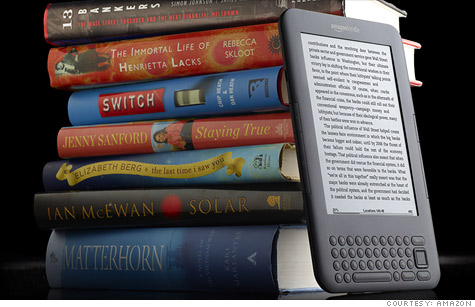
Amazon has its hands in all parts of the book publishing chain. Smaller publishers say it's a near-monopoly, but authors argue that Amazon simply offers a better deal.
NEW YORK (CNNMoney) -- Amazon's low-priced bestsellers and Kindle e-reader are famous for changing the book industry. What's not so well known is how deeply Amazon's tentacles reach into all parts of the industry, including its growing interest in inking deals with authors to publish some of the hit books Amazon sells.
Booksellers and publishers are crying foul, saying they're being cut out of the chain by an aggressive Goliath. But some authors who have recently signed with Amazon Publishing say the company simply offered them a better, fairer deal than traditional publishers.
And those Amazon deals are a boon for consumers, the authors say, because they bring earlier book releases and cheaper prices.
Amazon quietly launched its own book imprint in 2009. The effort expanded the next year into a line of foreign translations and another of "manifestos" from thought leaders, but it stayed fairly under-the-radar until this May, when Amazon brought in famed New York editor Larry Kirshbaum to head up its Amazon Publishing unit.
Kirshbaum quickly dumped gasoline on Amazon's publishing sparks: Last month, he signed uber-popular self-help author Timothy Ferriss, whose book The 4-Hour Workweek (published by Crown, a division of Random House) remains a perennial bestseller. Amazon plans to publish Ferriss's next book, The 4-Hour Chef, in April 2012, in all formats: digital, audio, and old-fashioned ink on paper.
Ferriss is the highest-profile author yet to jump ship from the traditional publishing houses, and his defection has rivals spooked.
"Amazon is holding the entire book industry hostage," says Oren Teicher, CEO of the American Booksellers Association. "First they disintermediated retailers, and now it's publishers and authors."
Amazon (AMZN, Fortune 500) declined to comment for this story.
Amazon's expanding reach: Amazon's lock on the entire book chain is "alarming," Teicher says, because the company is controlling so many parts of the industry. He cites Amazon's sales tax battle with California lawmakers as an example of its "enormous weight."
Teicher doesn't think that Amazon truly has a monopoly, but he warns "it's moving in that direction."
Dominique Raccah, CEO of independent Chicago-area publisher Sourcebooks, agrees that Amazon "could be" a monopoly already. Amazon's move into publishing "was completely expected," she says.
But she wonders if it really knows what it's getting into: "This is a business of lots of long-term investment, very little return and enormously detailed work."
Those details can get overlooked when big companies aren't careful. A preview chapter of Amazon Publishing's first romance e-book was made available to customers with the editor's notes still included, Raccah says. In a "normal" publishing process, about a dozen eyes would have seen the book before any copy went live.
Good deals for authors and readers: Authors who have signed with Amazon say they're sympathetic to the plight of booksellers and publishers, but the traditional route just isn't cutting it anymore.
Thriller writer Barry Eisler made headlines in March when he turned down a two-book deal with St. Martin's Press worth $500,000 in favor of self-publishing. But by May, Eisler had inked a deal with Amazon instead.
"A half a million dollars is attractive, but it always comes with caveats," Eisler says. "[Traditional] publishers are going to set the prices and the release date. They want to control the cover art and even the title."
Amazon, however, gave Eisler creative freedom similar to that of self-publishing, plus the benefit of a strong distribution and marketing channel.
A particular sticking point for Eisler was the e-book's release date. He asked about publishing his upcoming book The Detachment digitally six months before the paper release, but he says "that was a non-starter."
Amazon released the e-book version of The Detachment earlier this month. The print version won't go on sale until mid-October.
"Legacy publishing is about maintaining the position of paper and slowing down digital," Eisler says. "They don't want readers switching to digital because they can get the books earlier or cheaper. And then readers lose out."
He says his deals with traditional publishers typically gave him 17.5% of the retail price of the book, while self-publishing would have netted him around 70%. He won't reveal the cut that Amazon offers, but "it's much more favorable" than the traditional guys.
"Before, the choice of publisher was almost an illusion," Eisler says. "It was like choosing one player in a cartel. But now those legacy houses aren't the only game in town."
Joe Konrath, who writes under the pseudonym Jack Kilborn, also found more financial success when he went rogue. Eight of his books were published by Hyperion, Hachette and Berkley, a track record that gave him an income of about $300,000 over the course of nine years.
Then, in 2009, Konrath self-published a few novels on the Kindle. That's netted him more than $300,000 in 2011 alone.
Like Eisler, though, Konrath turned from self-publishing to sign with Amazon in May.
"Amazon treats its authors like partners, not like necessary evils," Konrath says, "With my previous publishers, I had zero say in important decisions. Amazon respects my [creative] decisions, [and] its marketing power is unmatched."
Amazon's stealth moves: Teicher, the ABA head, says the issue isn't about progress -- it's that Amazon is "using the book industry as a loss leader to get people to buy TVs."
"Book buyers are good consumers, and Amazon knows that," Teicher says. "So they get drawn in and then encouraged to buy different products. Meanwhile Amazon's hurting the book industry for the sake of profits."
Michael Norris, senior trade books analyst at Simba Information, agrees that Amazon has become "sort of the Wal-Mart of the Web." It's a one-stop shop for almost everything -- and its ambitions go far beyond books.
On Wednesday, Amazon is poised to build on the success of its Kindle e-reader and launch a tablet device that analysts expect to challenge Apple's (AAPL, Fortune 500) wildly popular iPad by significantly undercutting the iPad on price.
As more customers adopt Kindles, iPads and other devices that make e-books more attractive, the print-to-digital shift will start snowballing. By expanding its own publishing arm, Amazon accelerates the rate at which traditional publishers could find themselves entirely cut out of the supply chain.
The "Amazon effect" has already decimated one business: bricks-and-mortar bookstores. Barnes & Noble (BKS, Fortune 500) reported two straight quarterly losses this year, while Borders filed for bankruptcy in February and recently closed all of its stores.
If they want to avoid the same fate, publishers have just two options: Innovate or die.
As one example of a possible path forward, Sourcebooks publisher Raccah cites O'Reilly Media. In addition to its traditional book publishing, tech specialist O'Reilly hosts conferences, publishes a magazine and offers online training courses.
"Publishers have to add value wherever they can if they want to survive," Raccah says. "It's no longer enough to be just one thing." ![]()
Game consoles to bolster video capabilities
| | By Mark Milian, CNN September 27, 2011 -- Updated 1401 GMT (2201 HKT) | Filed under: Gaming and Gadgets |

San Francisco (CNN) -- When Microsoft released the first Xbox nearly a decade ago, analysts considered the then-money-losing endeavor to be a sort of Trojan horse into the living room: a bid to become the home's central media hub.
Now, Microsoft is facing an undisguised assault from Apple, Google, Samsung Electronics and start-ups like Boxee and Roku. They are all vying to fill the holes in Internet video on the big screen with hardware that makes it easy to watch on demand.
Microsoft and Sony, which makes the PlayStation, are working to bolster their Internet-video offerings before new challengers can usurp the home-entertainment market that they've been cultivating for many years with their systems.
Sony plans to unwrap a new version of its video-download service for the PlayStation 3 on Tuesday. People who subscribe to PlayStation Plus will be able to download a preview, and starting on October 11, all owners of the game console will be able to download the application from the home screen in the same way they can get Netflix.
The sleeker Video Unlimited has large text and cover artwork for movies and television shows. The overall design looks a lot like the Metro style Microsoft is using in Windows Phone 7 and Windows 8.
Video Unlimited will deploy a new patented search interface that works well with the arrow buttons on remote controls, which typically don't have keyboards, and the system suggests results as the user types -- much like Google's predictive search results. While surfing through menus, the app frequently makes recommendations about similar films and programs.
"We want you to be able to search and browse in a nonlinear way," Michael Aragon, a vice president for Sony Network Entertainment, said in an interview. "We want people to get lost in the experience."
The company is rebranding its Qriocity media suite, which includes a music-subscription service and the video store. Music Unlimited and Video Unlimited will live under the Sony Entertainment Network umbrella, and they may eventually be joined by the PlayStation Network, Aragon said.
For now, the PlayStation Network Store will continue to offer the same programming that Video Unlimited has, to cater to customers familiar with buying media through the existing store.
Music Unlimited and the PlayStation Network Store will be redesigned later, Aragon said. The music service has about 750,000 active users, and about 100,000 paying for access, he said.
Couch potatoes expect programs to start immediately, but Video Unlimited's a-la-carte downloads don't do that currently on the PlayStation. This already works on Sony's Blu-ray players that have the app installed, and will be coming soon to the PlayStation, Aragon said.
The redesigned video service will be coming to Sony set-top boxes and Bravia TVs in the next few months, Aragon said. The Sony tablet, which is set to debut early next month, will have a version of Video Unlimited, and the iPhone app will eventually include the ability to watch videos offline, he said.
With the new Web services, Sony is hoping to leave behind the blunders from earlier this year which resulted in a lengthy outage for its network. A reminder of those flared up recently when Sony asked its users to waive their rights to file class-action lawsuits. In the interview, Aragon boasted that Sony has added 3 million accounts and usage has increased by more than 10% since the outage.
But Sony's network division has more than its own recent mistakes to concern itself over. Google has been unwavering in developing its Google TV platform, which Sony installs on a few of its products. Some rumblings within supply chains suggest that Apple is working on a television set. Samsung is pushing its Smart TV system.
Even with more TV sets bundling Internet capabilities, the market for set-top boxes is expected to grow 14% this year to 21 million devices shipped, according to market research firm In-Stat.
Microsoft, like Sony, feels the heat and continues to push the Xbox beyond gaming.
"Your Xbox is becoming the hub of your living room," Microsoft CEO Steve Ballmer said at a conference in January. "It is your gaming system; it is your movies; it is your TV experience."
Ballmer expanded on this concept in a presentation at the company's developers conference last month. Microsoft plans to launch new video-on-demand and live TV services for Xbox in partnership with dozens of media companies, he said. There is already an ESPN channel for Xbox Live subscribers.
While Sony is optimizing its platform for existing remotes with the unique search feature, Microsoft is promoting the Kinect, with its microphone and camera for motion sensing, as the peripheral for navigating video content. Microsoft declined to make an executive available to be interviewed.
"Certainly we all know the frustrations of using guides and menus and controllers, and we think a better way to do all of this is simply to bring Bing and voice to Xbox," Ballmer said last month. "You say it; Xbox finds it."
With Zune Pass and Xbox's limited video programs, Microsoft has favored subscription models. It's unclear how the new Xbox services will be packaged.
Nintendo has been testing the waters on 3-D media delivery through its 3DS hand-held. The Wii is not seen as a media hub, though it can access Netflix.
Netflix has about 24 million subscribers, and the game consoles have been a primary way people get the service. Sony favors a la carte over "the Netflix model," Aragon said, because it can offer new films close to when they are released on Blu-ray. "If you want to do subscriptions, you can't have new content," he said.
Sony is considering offering a subscription service catering to young men, which would include anime films, Aragon said. "PlayStation has such a strong tie to the gamer market," he said.
Subscriptions are thriving, evidenced by Netflix's success and by Amazon.com's partnership with 20th Century Fox, announced Monday, for the Instant Videos service. Microsoft and Sony would like to sell the media, not just the hardware that plays them. But if their gaming consoles were truly home-entertainment Trojan horses, the clock is ticking for them to spring their surprise.
Facebook to launch iPad app at Apple's iPhone 5 event
| By Ben Parr, Mashable September 27, 2011 -- Updated 1139 GMT (1939 HKT) | Filed under: Social Media |
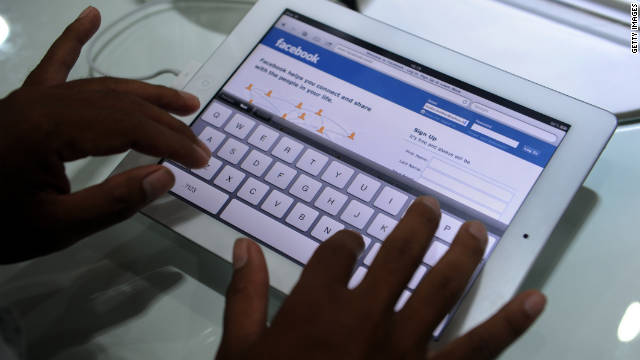
(Mashable) -- Facebook will launch its long-awaited iPad app at Apple's iPhone 5 launch event on October 4, Mashable has learned. In addition to the iPad app, Facebook is also expected to release a revamped version of its iPhone app and may unveil an HTML5-based mobile app marketplace.
The Facebook iPad app, which leaked earlier this year, has been in limbo at Facebook for the past few months. That much was made clear in a blog post Monday by former Facebook engineer Jeff Verkoeyen. In that post, he revealed that he left the company (for Google) partially because Facebook has been sitting on the completed app since May.
The problem, according to two sources familiar with the situation, has been a combination of timing and a strained relationship with Apple. It's no secret that the two companies have been at odds over various issues during the past two years.
For example, the social network pulled the plug on Facebook Connect in Ping because Apple didn't give Facebook any warning about the feature, which would have eaten a great deal of bandwidth on Facebook's side.
We've also heard rumors that Facebook was supposed to be integrated into iOS. This was meant to happen years ago, but disagreements on both sides eventually led to Apple integrating Twitter into iOS 5.
The relationship between the two technology giants is warming up, however, thanks to the shared goal of beating Google -- and the simple fact that Facebook and Apple may need each other. The former doesn't have a mobile platform while Apple doesn't have a social platform. The culmination of this renewed friendship: the launch of Facebook for iPad at Apple's iPhone 5 media event.
At this event, our sources also expect Facebook to unveil a new version of Facebook for the iPhone, with design and speed improvements that mimic the iPad app.
Facebook has also been working on a project to bring the Facebook Platform to mobile devices. The project, labeled "Project Spartan" by some (a name not used internally at Facebook, according to one of our sources), is designed to be a platform where developers can bring their Facebook apps to mobile devices via an HTML5 platform.
What we're hearing is that Apple is actually working with Facebook on perfecting the HTML5 platform. This could also launch at Apple's upcoming iPhone event, though our sources wouldn't commit to a specific launch date for the platform. Facebook decided not to launch it at f8, as it didn't want to water down the announcement of the new Facebook Open Graph and Timeline.
When we said last week that Facebook would be profoundly changed, we weren't just referring to the new Facebook Open Graph and the "frictionless sharing" touted by Mark Zuckerberg. We were also talking about its secretive effort to become a mobile platform for the social web. And thanks to Apple, it looks like that effort is about to come to fruition.
We've reached out to Apple and Facebook for comment.
Chelsea Clinton joins IAC board

NEW YORK (CNNMoney) -- Chelsea Clinton has joined the board of directors at IAC, the Internet media giant said late Monday.
IAC (IACI), headed by media mogul Barry Diller, said in a regulatory filing that former First Daughter Clinton was elected to the post on September 22.
IAC operates more than 50 Internet companies in 30 countries, including Match.com, CollegeHumor and Vimeo. It also retains a 50% stake in The Newsweek/Daily Beast Company, after launching The Daily Beast in 2008 with Tina Brown.
Clinton, 31, is currently serving on other boards -- but they're quite different from IAC. She's a director at the Clinton Foundation, the School of American Ballet, Common Sense Media and the Weill Cornell Medical College.
Clinton is currently pursuing a Ph.D. at Oxford University and working at New York University. Before that, she worked at McKinsey & Co. and Avenue Capital.
Also elected to the IAC board is Sonali De Rycker, 38, who is a partner at London-based global venture firm Accel Partners.
De Rycker previously worked at Atlas Venture on investments in the Internet and software sectors. She was formerly an investment banker at Goldman Sachs. De Rycker also serves on the boards of several private companies.
Other IAC board members include Diller, former Disney (DIS, Fortune 500) CEO Michael Eisner and former Sears (SHLD, Fortune 500) CEO Arthur Martinez. ![]()
Digital monkeys with typewriters recreate Shakespeare
| | By Doug Gross, CNN September 26, 2011 -- Updated 1950 GMT (0350 HKT) | Filed under: Web |

(CNN) -- It's a time-honored adage about the laws of probability: Give 1 million monkeys 1 million typewriters and they'll eventually type the entire works of William Shakespeare.
Now, a software developer in Nevada is putting that saying to the test. And his digital monkeys are off to a good start.
This weekend, Jesse Anderson wrote on his blog that a computerized simulation of the theoretical simian typing pool has completed "A Lover's Complaint," a narrative poem that appeared in a book of The Bard's sonnets.
"This is the first time a work of Shakespeare has actually been randomly reproduced," Anderson wrote. "Furthermore, this is the largest work ever randomly reproduced. It is one small step for a monkey, one giant leap for virtual primates everywhere."
Anderson's virtual monkeys began typing on August 21. Using open-source software called Hadoop, he created a huge group of "monkeys" that input random strings of gibberish. When a chunk of text matches a word used in Shakespeare's catalogue, it gets crossed off of a database of the plays and poems.
His database comes from Project Gutenberg.
So far, he said, over 5 trillion character groups have been churned out.
Based on a page updating the project's progress, several more works might be checked off the list soon. The monkeys appear to need only two more words to complete the comedy "The Tempest" and seven more to bang out "As You Like It." (There's been no explanation for why the computer monkeys seem to be lagging behind on Shakespeare's tragedies.)
"The monkeys will continue typing away until every work of Shakespeare is randomly created," Anderson wrote.
Permutations of the Infinite Monkey Theorem dates back as far as Aristotle (although he obviously didn't have a typewriter).
Anderson's inspiration came from a perhaps less likely source: "The Simpsons."
He says it harks back to a "Simpsons" scene in which Mr. Burns chains up 1,000 monkeys, giving them the task of writing a great novel and berating one of them for typing, "It was the best of times. It was the blurst of times."
Anderson's approach is, if nothing else, gentler.
"No monkeys were harmed during the making of this code," he wrote.
Thứ Hai, 26 tháng 9, 2011
Chủ Nhật, 25 tháng 9, 2011
With a nudge from Facebook, streaming music lowers barriers
| | By Mark Milian, CNN September 23, 2011 -- Updated 2256 GMT (0656 HKT) | Filed under: Web |
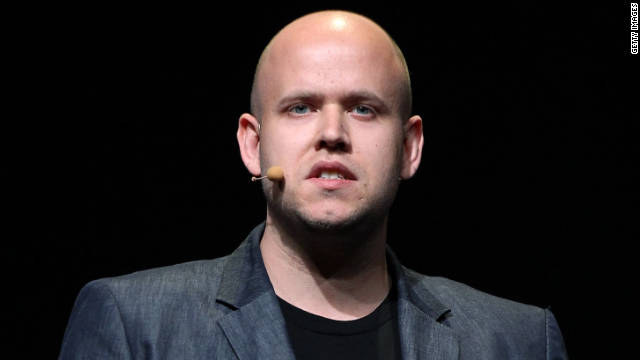
San Francisco (CNN) -- When Spotify debuted in the U.S. two months ago, the streaming-music service was starkly different from its competitors.
For one, Spotify was the only clearly legal service that let people listen to every song in its digital catalog on demand for free, without making them jump through hoops by signing up for some kind of time-limited trial run.
It's well designed; integrates with iTunes, the most popular jukebox from Apple; lets you blast songs to friends via Facebook; and did we mention that it's free? To quote Facebook CEO Mark Zuckerberg in a 2009 status update during Spotify's Europe-only days, "Spotify is so good."
So, naturally, when Zuckerberg first took steps to design a music section for Facebook, he went to Spotify CEO Daniel Ek and Sean Parker, the former Facebook adviser who now sits on Spotify's board of directors. But ultimately, rather than reaching an exclusive deal with Spotify, Facebook chose to partner with more than a dozen companies, including other music services such as MOG, Rdio and Rhapsody.
These deals may have another, indirect consequence: bringing more free music to more Internet users on multiple sites, not just Facebook.
MOG and Rdio announced just hours apart last week in advance of Facebook's conference that they were adding more robust free music offerings. Rhapsody, which has been in the game the longest, will offer an extended trial of 30 days to Facebook users. (In other words, to just about everyone.)
MOG's free service grants users a sort of gas tank that can be filled by completing tasks on the service, such as creating playlists or referring friends to sign up. The viral-marketing program was inspired by another cloud service called Dropbox, and MOG will also have advertisements to offset some of the costs of offering free music, MOG CEO David Hyman said in an interview on Thursday.
"This massively lowers the bar for what you need to do to get free music," Hyman said.
Rdio's free service, which is coming "in the very near future," will provide access to its 11 million tracks without ads, a spokesman said. He declined to elaborate on how this will make financial sense for the company.
What all of these services have in common is that they'll work with the new music hub that Facebook unveiled on Thursday. This means they likely will give users the option to automatically alert Facebook about every song they listen to, and then let the social networking giant create reports about their listening habits.
Facebook is attempting to bring this same concept to news, video, books and other applications. Whether people actually want to let Facebook log every news article they read is uncertain, to say the least. When it comes to video, giants like Google's YouTube and Vimeo are missing from Facebook's new platform; Hulu's offering appears unchanged; and Netflix is launching Facebook integration everywhere except for in the U.S. for now.
In other words, Facebook's stab at hosting music looks the strongest, despite lacking deals with giants iTunes or Pandora, neither of which are on-demand song-streaming programs. Zuckerberg introduced his new music product by saying he wanted to "rethink the whole music industry."
Bringing personal recommendations to some 750 million Facebook users introduces a new variable to digital music. People may look to music reports on their friends' Facebook profiles -- "Fred is listening to the new OK Go album" -- for suggestions instead of the radio or stores.
Considering the major shift in recent months from walled online music subscriptions to extensive free listening, and the comments from executives at the streaming companies, everyone appears open to the idea.
While torturous record-label negotiations were once like a trip to the dentist, "it gets a little bit easier dealing with them every day," Hyman said. Spokesmen for two of the major labels didn't immediately respond to a request seeking comment.
Rhapsody, which has been around for nearly a decade, is taking a relatively cautious approach with its 30-day trial. Digital music has never seen a scenario quite like the one now, with so many options for free music, Rhapsody President Jon Irwin said in an interview. The few that have tried something similar, like iMeem, iLike and Lala, "have come and gone," he said. These services have to pay performance royalties each time someone starts playing a song, which can add up very quickly.
"At some point, the economics have to balance," Irwin said. "Somebody has to pay for that."
MOG put at least a year of investigation into the likely costs associated with its free service, Hyman said. Engineers plan to continue tweaking as more people sign on through Facebook, he said. This "Facebook experiment," as some in the music industry are calling it, may still prove to be less costly than other vehicles of marketing and advertising, executives said.
"One can say it's an experiment, but we've certainly done a ton of research," Hyman said. "It's still cheaper than me buying search engine marketing, display advertising or traditional marketing."
Spotify appears unfazed by the mounting competition. The service recently passed 2 million paying subscribers, Ek, the CEO, said this week. People who use Facebook are more likely to sign up for Spotify's paid service, executives said on Thursday, citing its own research.
"Ours is the best free service there is," Kenneth Parks, Spotify's content chief, said in an interview.
But that free offering won't stay golden forever. Around the end of the year, Spotify will impose more limits on U.S. users, in line with per-month listening restrictions and ads that Spotify users in Europe already see.
Thanks to recent sizable venture-capital investments, Spotify certainly doesn't appear to be hurting for cash.
After Facebook's announcement on Thursday, Parker and Spotify hosted an extravagant party in San Francisco for conference attendees, with tequila bottles stationed at tables and concerts by such artists as Killers and Jane's Addiction. Everything, of course, was free.
Groupon's latest accounting revision whacks sales in half
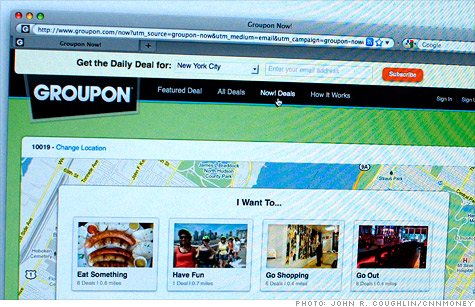
NEW YORK (CNNMoney) -- Every time Groupon revises its accounting to strip away another feat of financial gymnastics, the picture grows grimmer.
In a late-Friday regulatory filing, daily deals merchant Groupon updated its reported sales to "correct for an error" -- namely, including in its revenue the cash it has to hand back to merchants for their share of the coupons Groupon sells.
Strip away those payments, and the company's revenue numbers change radically.
For the first half of 2011, Groupon is now reporting revenue of $688 million -- a big drop from the $1.5 billion it claimed previously. For 2010, its last full year of operations, Groupon is now reporting sales of $313 million -- down from its previous $713 million.
For example, say a Groupon subscriber paid $10 for a coupon. The company might keep $5 of that and pass $5 on to the merchant. But Groupon was previously reporting all $10 as revenue.
The change didn't significantly affect Groupon's calculation of its earnings -- or, more accurately, its losses. The site said Friday that it had a net loss of $224 million in the first half of 2011.
This isn't the first time Groupon has had to back away from its accounting habits.
When Groupon filed in early June for its IPO, the company drew a barrage of criticism for its reliance on a nonstandard metric called "adjusted consolidated segment operating income." The unwieldy "ACSOI" stripped out Groupon's steep costs for marketing and acquiring new subscribers -- and it made a big difference in the numbers.
Under pressure from the Securities and Exchange Commission, Groupon re-filed last month to remove ACSOI and instead use only standard accounting procedures. That cast the site's losses into sharper relief.
In its amended filing on Friday, Groupon offered an amusing response to its critics: "The change in presentation reflects, in our view, the challenges that participants in new industries confront in the application of accounting standards."
In other words: "Math is hard!"
Groupon also slipped into its filing the news that one of its key executives, COO Margaret Georgiadis, resigned this week after five months on the job.
Groupon -- which now has 9,625 employees worldwide -- lured Georgiadis away from her previous employer, Google (GOOG, Fortune 500), to help structure the sprawling and fast growing company. Now Google has drawn her back: She's returning to the company in the newly created position of president of the Americas region.
Georgiadis won't walk away from Groupon empty handed. Though she'll forfeit most of the 1.1 million shares of restricted stock granted in her employment agreement, she'll get to keep 300,000 shares that have already vested.
Blockbuster launches Netflix streaming rival -- sort of
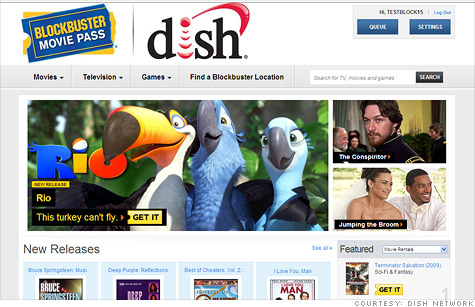
Blockbuster Movie Pass bundles Dish's traditional cable TV plan with Blockbuster's DVD-by-mail service and some streaming video.
NEW YORK (CNNMoney) -- Blockbuster was expected to launch a Netflix rival on Friday -- and it did, kind of.
"Blockbuster Movie Pass," launching October 1, bundles Dish's traditional cable TV plan with Blockbuster's DVD-by-mail service. It also includes some streaming content: a library of 3,000 movies will be available for streaming to a TV, or 4,000 if you stream to computer.
That's a small subset of the 100,000 DVDs and video games Blockbuster says it has stocked in its by-mail catalog.
The service costs $10 a month as an add-on to a Dish subscription. New customers who sign up for Dish's "America's Top 200" package for $39.99 a month -- or any more expensive service -- with a 2-year contract will receive the service for free for one year.
New subscribers who sign up for Dish's "America's Top 120" package will get Movie Pass for free for three months.
The streaming catalog includes shows from Fox, Cartoon Network, Discovery, Epix, Fox, DIY, HGTV and TBS. A more specific list of content was not immediately available.
Blockbuster has long been teasing plans to launch a streaming service to compete head-on with behemoth Netflix (NFLX), whose recent price hike has led to consumer backlash and a scaled-back subscriber forecast. Friday's move is a step in that direction, expanding Blockbuster's streaming services beyond the pay-per-rental model it currently uses.
But like Netflix, Blockbuster faces obstacles in getting monthly subscribers access to the most popular movies and TV shows. Its pay-per-rental catalog features recent releases like X-Men: First Class and Bridesmaids, priced at $3.99 for 24-hour viewing rights. Those titles aren't likely to show up in its all-you-can-watch unlimited streaming offering.
Blockbuster didn't immediately comment on what content is included in its "Movie Pass" package. The package also isn't available to non-Dish subscribers, though company executives said to "stay tuned" for later announcements on that front.
Dish Network (DISH, Fortune 500) acquired Blockbuster in April for $320 million in a bankruptcy court auction. Blockbuster's U.S. businesses filed for Chapter 11 protection in September 2010, hoping to sharply reduce their nearly $1 billion debt. The company put itself up for sale in February 2011.
Blockbuster struggled for survival ever since media conglomerate Viacom (VIA) spun off the company in 2004. Its brick-and-mortar stores were bleeding cash as traditional video renting declined, and competition from Netflix and Coinstar's (CSTR) Redbox kiosks heated up.
But Blockbuster will also face high competition in the streaming space, both direct rivals like Hulu and big tech players that are eying the space, including Amazon (AMZN, Fortune 500) and Google (GOOG, Fortune 500).
Studios and cable providers have been careful not to let any single streaming service nab all of the valuable content. As a result of carving up the streaming video market, each service offers something a little different -- and no one can boast that they let customers watch all of their favorite shows. ![]()
Amazon's Android tablet is coming soon
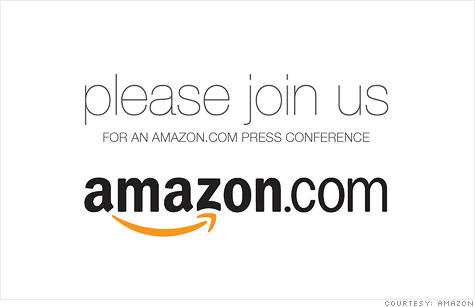
The invitation that Amazon's PR firm sent to media, announcing a press conference that's likely about the Amazon tablet.
NEW YORK (CNNMoney) -- The news that Amazon is building its own Android-based tablet has been an open secret for months. Next week, the mythical device is likely to be unleashed.
Amazon's (AMZN, Fortune 500) PR firm sent an invitation to journalists midday Friday announcing a press conference in New York City on September 28. The e-mail did not include any details, but the the date matches up with the expected timeline for the Amazon tablet's release.
For a device that hasn't yet been released, the Amazon tablet has already received a lot of media play. Earlier this month, TechCrunch's MG Siegler wrote that he had used the tablet.
The tablet runs on a tweaked version of Android, has a 7-inch tablet touch screen and is backlit, Siegler wrote, concluding that it's "going to be a big deal. Huge, potentially."
Analysts have even made sales forecasts about the yet-to-exist tablet, with Forrester analyst Sarah Rotman Epps writing way back in March that the market is ripe for disruption from Amazon.
Late last month, Rotman Epps released another report titled "Amazon Will Be Apple's Top Competitor in Tablets." Within a year, she predicts, "'Amazon' will be synonymous with 'Android' on tablets."
The key is for Amazon to "compete on price, content, and commerce," Rotman Epps says. If Amazon hits the right price point -- one that significantly undercuts the iPad -- and can keep up enough supply to meet demand, she expects Amazon's tablet will "easily" sell 3 million to 5 million units in the fourth quarter.
By comparison, Apple (AAPL, Fortune 500) sold 3.27 million iPads in the tablet's first quarter of existence. In its latest quarter, which ended June 30, Apple sold 9.3 million iPads.
If Amazon can unseat Apple as the tablet king -- or even make a dent, really -- it will have pulled off what several others have largely failed to do.
In the most extreme example, HP (HPQ, Fortune 500) killed off its TouchPad last month after just 49 days on the market. Other rivals are hanging on, but most of their devices have flopped critically and commercially.
BlackBerry maker Research in Motion (RIMM) released its PlayBook tablet in April to harsh reviews criticizing the device's unfinished feel. Two Android-based tablets -- Samsung's Galaxy Tab and Motorola's (MMI) Xoom -- debuted at prices above the iPad's $499 price point. Their sales have disappointed. ![]()
Users not happy with new Facebook changes
| | By Doug Gross, CNN September 23, 2011 -- Updated 1636 GMT (0036 HKT) | Filed under: Social Media |
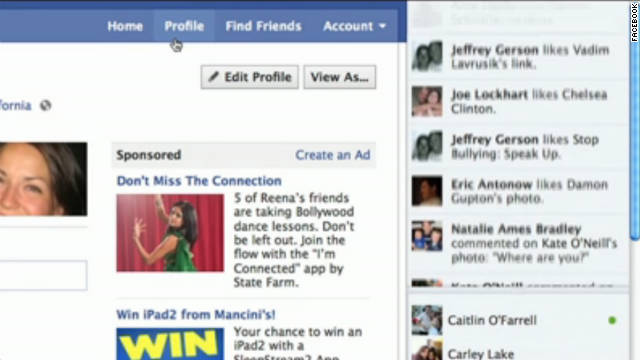
(CNN) -- Here we go again.
Facebook has made big changes to users' pages, and people are responding in droves with their metaphorical "dislike" buttons.
News Feeds were popping with not-so-gentle complaints Wednesday as many of the social-networking behemoth's 750 million users began seeing the overhaul.
"This is absolutely the worst of the many wrong-headed 'improvements' you have made, and that's quite a feat," a user named Franklin Habit wrote on the site's official Facebook page. "I think Facebook's usefulness to me has now been outstripped by its lack of ease in use."
Others were more succinct.
"This sucks," wrote user Brandon Howell. "That is all."
To be fair, griping about Facebook changes is a time-honored hallmark of the site. Change is hard for some people, and users grumble every time Facebook revamps their pages.
And it's perhaps a touch on the ironic side that many of the current complaints are coming from folks who, in turn, complained in December when the current format was rolled out. Or the time before. And the time before that.
Which isn't to say that the changes aren't pretty dramatic.
Instead of defaulting to your friends' most recent posts, the News Feed (which people hated when it was introduced) is now topped in many cases by what Facebook calls "Top Stories" for you. It uses an algorithm that combines such factors as which friends you interact with most and which friends' posts have the most comments and "likes" on them.
That algorithm, of course, was in its infancy on Wednesday, leading many users to say the top stories that Facebook suggested were random, at best.
"The 'top stories' needs to be gotten rid of," wrote user Kristy Montaney. "They're out of context and I want to check my News Feed from most recent to oldest, none of this 'top stories' stuff."
In a post on The Facebook Blog, developer Mark Tonkelowitz said the idea is to help people who may not log in to the site all the time find the best content, not just the newest.
"Now, News Feed will act more like your own personal newspaper," he wrote. "You won't have to worry about missing important stuff. All your news will be in a single stream with the most interesting stories featured at the top."
If you check Facebook more frequently, he said, you'll see newer stories at the top of your feed.
The other most glaring change Wednesday was a new, scrolling rail on the right side of the home page. Facebook calls it the Ticker. We're partial to "The ADD Bar," because the feature seems pitched to our attention-deficit lifestyles with its rapidly streaming nuggets of friends' activity.
If a friend "likes" an update, comments on a post or subscribes to a page, it now pops up in the -- OK, we'll say it -- somewhat Twitter-like timeline.
Haters were calling it distracting. But Tonkelowitz believes the Ticker plugs the gap in the time lag the News Feed sometimes experiences, letting users have more real-time interactions.
One apparent quirk of the Ticker is that when a friend interacts with a nonfriend (say, likes the status update of someone you're not friends with), clicking on that activity will show the original post.
Tonkelowitz's blog post said the Ticker "shows you the same stuff you were already seeing on Facebook."
Facebook spokesman Jonathan Thaw clarified this in an e-mail to CNN. "If you can't see a post because of its privacy settings, it won't show up to you anywhere on Facebook, including in your News Feed or in [the] ticker." he said. "Commenting or liking a post doesn't change its privacy settings."
In the history of Facebook changes, the pattern has typically been that users complain loudly at first and threaten to leave the site but then eventually learn to live with, if not like, the new approach.
This time may be somewhat more interesting in that it's the first major Facebook overhaul since Google rolled out its rival social networking site, Google+.
Many of the anti-change posts Wednesday were coupled with threats to defect to Google+ if things aren't changed back.
And interestingly -- and, we have to assume, coincidentally -- the Facebook overhaul was announced on the same day that Google+, previously an invite-only affair, was opened to the public.
Solyndra executives plead the 5th
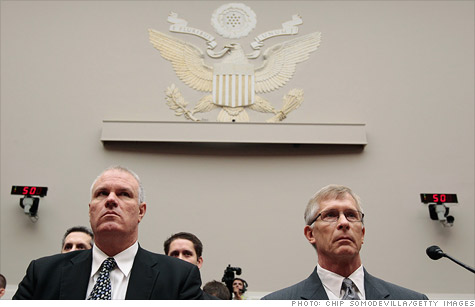
Executives from the bankrupt solar panel maker Solyndra refuse to answer questions surrounding the $535 loan guarantee they received from the government.
NEW YORK (CNNMoney) -- Lawmakers at a hearing on Capitol Hill Friday pledged to press ahead with their investigation into bankrupt solar panel maker Solyndra, despite silence from company executives who invoked the fifth amendment.
"Was all the information they submitted complete, what did they know, and when did they know it," Rep. Cliff Stearns, the Florida republican who heads the House Subcommittee on Oversight and Investigations, said during a hearing on the matter. "We will get to the bottom of this."
Solyndra executives Brian Harrison and W.G. Stover were present at the hearing. They maintained no wrongdoing took place at the company, but repeatedly refused to answer any questions on the advice of their attorney.
Solyndra declared bankruptcy last month. The company received a $535 million loan guarantee from the Energy Department in 2009 under a program started by President Bush and expanded as part of the Obama's administration's stimulus effort.
It's generally thought the company's more advanced solar technology couldn't compete with the rapidly falling prices of traditional solar panels.
Agents from the FBI and the Energy Department's inspector general's office raided the company's office earlier this month. Neither agency would comment on the nature of the raid, but the inspector general typically investigates cases of wrongdoing at the Energy Department and the entities it does business with.
Lawmakers on the oversight committee are conducting their own investigation. They want to know why one month before it filed for bankruptcy the executives told them and DOE that the company was doing just fine.
Solyndra's loan guarantee did not come in one chunk, but was handed out in stages after meeting milestones set by the DOE. The company ultimately drew down $527 million of the $535 million offered.
Lawmakers also want to know if the Energy Department rushed out the loan guarantee, either to jump-start the stimulus program or due to political pressure.
"Was the White House duped by Solyndra, or did they ignore the information to put green energy in a better light, or for more onerous reasons," asked Nebraska Rep. Lee Terry, a Republican.
One of Solyndra's main financial backers was also a big fundraiser for Obama in 2008 and lawmakers have questioned whether that played a part in the loan guarantee.
Lawmakers wanted to know the nature of several meetings between the Solyndra executives and White House aids over the last couple of years.
"On advice of my counsel, I invoke the privilege afforded by the fifth amendment to the U.S. Constitution, and I respectfully decline to answer any questions," was the response from each executive to every question.
Energy Department officials maintain there was no inappropriate political pressure that factored into the loan guarantee, noting that the company received major financial support from the private sector as well, including from an investment fund run by noted Republican donors.
Regardless of any wrongdoing at Solyndra, the company's bankruptcy has turned into an ideological fight on Capitol Hill.
Critics hold it up as an example of why the government shouldn't be funding start-up companies, especially ones with unproven technology like certain forms of renewable energy. If the technologies really do work, they say, they will attract funding from the private sector.
Supporters say government support for clean energy is essential if the nation is going to move away from fossil fuels and compete with countries like China, which lavishes support on its own renewable energy industry.Solyndra haunts other government-backed solar firms

Falling prices helped to bankrupt Solyndra. The Energy Department has $806 million riding on similar solar firms, are they also doomed?
NEW YORK (CNNMoney) -- At least three other government-backed solar firms face the same challenging market conditions that brought down Solyndra, the now bankrupt solar panel maker that could cost taxpayers over $500 million.
The Solyndra bankruptcy is now the subject of an investigation and a fierce partisan fight in Congress.
The company's downfall is generally thought to have been caused by the declining price of silicon.
Solyndra didn't use silicon. But many of its competitors did -- traditional solar firms like Sunpower (SPWRA), Trina Solar (TSL), Yingli (YGE) and Jinkosolar (JKS). Solyndra was banking that high silicon prices would give it a competitive advantage.
When silicon prices plummeted, Solyndra lost its edge.
And Solyndra wasn't alone. Three other firms the Energy Department has backed are relying on the same principle.
Those companies include Abound Solar, Solopower and 1366 Technologies. Together, they have received $806 million in loan guarantees from the Energy Department.
Are they also doomed? Experts say that if they can further develop their technology they may have a fighting chance but market conditions in the near-term are working against them.
Solyndra failure shows rift over taxpayer role
"Part of their business plan was based on solar grade silicon having a high cost," said Scott Brown, chief executive of the private equity firm New Energy Capital. "That premise is no longer there."
Abound Solar said its panels are still competitive, and 1366 Technologies was unavailable for immediate comment. Solopower did not return a call and email.
An Energy Department spokesman said the agency was not worried about these companies failing, saying it conducts rigorous reviews of all the ventures it funds.
Falling prices: Silicon prices have fallen from about $500 a ton a couple years ago to $50 a ton today, said Brown, thanks in large part to major investment in silicon-producing plants by China.
China's investment in silicon as well as its huge investments in solar panel makers, combined with weaker demand worldwide as subsidies expire in Europe, caused the price of traditional solar panels to plummet.
In the last year alone they fell some 40%.
All across the globe, solar panel makers, especially ones that were developing more advanced technology, are finding it hard to compete with the Chinese as the price of solar panels drops.
But for the rest of the industry, cheap solar panels are great news.
Cheaper panels mean more people will switch to the clean technology. Work has been booming for solar installers, project developers, and financiers. Just this week the industry said solar power capacity in the United States jumped 69% in the second quarter compared to the same time last year.
The Energy Department, as part of its plan to fund R&D and commercialization of renewable and clean energy technology, has backed or is considering backing loans to 42 firms across the sector totaling $39 billion in funding.
Most of the loans have gone to lower risk generation projects like big wind and solar farms which have signed long-term power purchase agreements with utilities.
But a handful of the loans were considered to be higher risk because they went to cutting edge manufacturers. Among them are makers of so-called thin film solar technology.
Thin film panels, which use no silicon, produce less electricity per panel than traditional silicon ones. But they are cheaper to produce, and are therefore ideally suited to large-scale deployment.
"If solar is going to be on par with coal, thin film is likely the answer," said Jessie Pichel, head of clean energy research at the investment bank Jefferies & Co. "But they need more time to develop the technology. The near-term outlook is quite bleak for thin film companies."
The collapse in prices for traditional solar panels has made it even more important for the industry to further develop thin film technology that can compete. Pichel said many thin film firms have scrapped production plans and gone back to the research lab.
Not so for ill-fated Solyndra. Its combination of thin film technology with a cylindrical design went head-to-head with traditional panels. The firm went belly up last month.
Still in the game: Abound Solar, which got a $400 million loan backed by the DOE, isn't backing down either.
Julian Hawkins, head of sales and marketing for Abound, said the firm is using some of the money to add a second line of production at its Colorado facility, and then plans on using the lion's share of it to revamp an old DaimlerChrysler building outside of Kokomo, Indiana, starting in 2012.
Hawkins said the fall in silicon prices has been difficult for the firm in the short term, but that Abound's strategy relies on improving the manufacturing process itself, not the technology in particular.
He says the company's solar panels are already competitive with traditional silicon panels.
"Making solar panels more cheaply is the basis of the company," said Hawkins. "We're still on track."
The Obama administration, which has taken considerable heat over the Solyndra collapse, is clearly hoping that optimism pans out. ![]()
Haptic device gives blind a helping hand
| | By Matthew Knight, CNN September 23, 2011 -- Updated 1116 GMT (1916 HKT) | Filed under: Innovations |
 San Francisco-based inventor Steve Hoefer has developed a prototype haptic device which applies pressure to the wrist when objects come in range of its sensors.
San Francisco-based inventor Steve Hoefer has developed a prototype haptic device which applies pressure to the wrist when objects come in range of its sensors. (CNN) -- It started out life as a new video game concept but quickly morphed into a prototype with a far more practical vision -- a haptic device to help the blind and visually impaired.
Tacit is a wrist-mounted device which informs the wearer about the proximity of objects in complex environments, according to its creator Steve Hoefer.
Ultrasonic sensors positioned at the front measure distances from one inch up to 10 feet (2cm to 3.5m), Hoefer says, while motorized rubber pads at the rear apply increasing amounts of pressure on the wrist as users get closer to an object.
The original idea was rather different. Hoefer wanted to create a "dungeon crawl" game (a type of fantasy role-playing adventure set in labyrinths) that didn't rely on vision. So he built a haptic headband complete with sensors and vibration motors.
Steve Hoefer
It worked, but there was a problem. He kept crashing into things that weren't at head height and the vibrations drove him batty, he says.
Moving the remodeled device to the back of his hand not only saved him a lot of stubbed toes, but also steered the project in its new direction.
The prototype is powered by a standard nine volt battery and can be worn on either hand. It's cheap too, with materials totaling around $75, Hoefer says.
So far, tests with the blind have been very positive, he says, and it's attracting interest from educators, designers and researchers in the field.
Robin Spinks, principle manager of digital accessibility at the UK's Royal National Institute of Blind People thinks the device shows promise.
"Orientation and mobility are critical skills for a blind person's independence, education, employment and quality of life. Electronic orientation devices, such as Tacit have the potential to enable individuals to move around independently and gain confidence," Spinks said.
San Francisco-based Hoefer is currently working on reducing Tacit's size as well as improving its accuracy and simplifying its construction.
"It's not perfect, but it works, and it can be better," Hoefer said.
"It could easily be made about half the size, and the replaceable batteries should be replaced by rechargeables with a blind-friendly charging method -- either a wireless or magnetically-aligning power plug."
"One of the biggest and best criticisms is that it is very difficult for a blind person to build their own. I hope to address that in a future version," he said.
Hoefer has released details of Tacit's materials, circuits and software on his Grathio Labs web site under a Creative Commons license to maximise feedback and hopefully improve the design.
"There are a number of improvements and changes left to be made. I'm curious to see what happens," he said.
